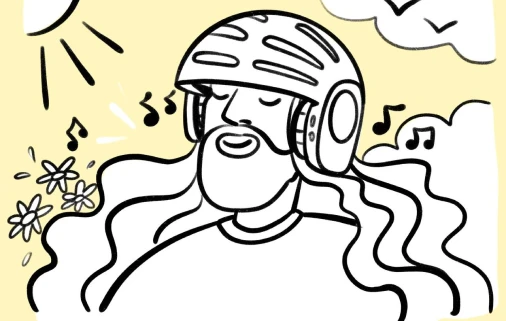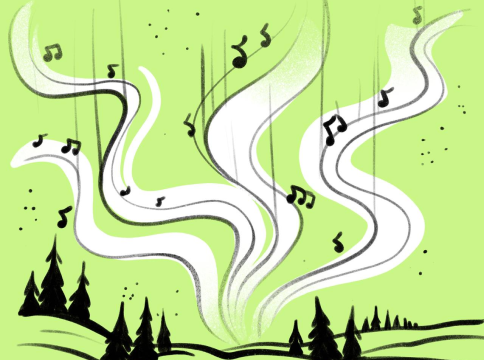How music stimulates hair growth and what the Northern Lights sing about
Storms, hurricanes, tornadoes, and earthquakes of neural connections accompanied by sparks and flashes in the head – this is how ordinary communication unfolds between students and a physics professor at the University of California.
An unconventional approach in presenting material and a brainstorming session during lectures is a common occurrence for future scientists, as it seems like an electric current is connected to them at every class, activating their brain activity.
The unorthodox mentor passes each student’s thoughts through the meat grinder of his experience and unconventional thinking, modelling fantastic conditions where sleep-deprived students gather their strength and solve problems with multiple unknowns. What will happen today?
The professor entered the room and wrote a question on the board:
— What is music capable of?
The future scientists glanced at each other in bewilderment; the physics professor’s question seemed too simple to them.
— I demand not only elementary life solutions from you but also original technological solutions.
With these words, the professor left the auditorium, and the students began to solve the unusual task. The most unusual solutions of the students are outlined in the article.
Some students based their solution on the belief that music can bring joy, relaxation, and help feel emotions more acutely. This group of students decided to bring a synthesizer into the auditorium not only to tell but also to visually demonstrate what music is capable of. And that’s a quite realistic scenario.
The female students, on the other hand, operated on the belief that music makes the world more beautiful and transforms people. As well, it’s quite a life-affirming solution.
This group of students brought a helmet into the auditorium, which looked more like bulky headphones. This helmet was developed by the British company CurrentBod for hair growth restoration. Acceleration of hair growth and rejuvenation of the scalp are provided by low-level light therapy. The LED helmet performed so well that it was approved by the US Food and Drug Administration.
By the way, research conducted by the Department of Medical Cosmetology at the Medical Academy of Postgraduate Education in St. Petersburg has confirmed that broadband light impulses can have a stimulating effect on hair follicles. Even after a single treatment, hair density in the treated area increases by 30%, hair diameter by 10%, with no negative consequences for the skin: pH, elasticity, and moisture content remain normal.
The secret lies in the fact that the therapeutic helmet with diodes is also musical, and the musical accompaniment plays a special role in the hair growth process. The helmet is equipped with Bluetooth headphones, allowing users to listen to music while waiting for the 10-minute session to finish. Even a 10-minute break relieves stress, distracts from problems, and has a beneficial effect on the body, as well as, of course, on the hair follicles. However, the manufacturing company has not yet determined which genre of music specifically activates the work of the scalp follicles.

Among the students who enjoyed solving unusual problems, there were those who decided to answer the professor’s question using science.
The future luminaries of science remembered an interesting fact: when the Northern Lights appear in Canada, Scotland, and Norway, many residents of these areas hear a sound unlike anything else. Witnesses describe this sound as scraping, whispering, whistling, and humming, and claim that the sound only occurs during the Northern Lights. Therefore, residents of northern regions see a close connection between these noise effects and the bright light in the sky.
For a long time, no one took the accounts of witnesses seriously, dismissing the “singing of the Northern Lights” as the product of hallucinations from overly sensitive natures, mesmerized by the unusual phenomenon.
However, this music found a scientific explanation. Eight years ago, Finnish researchers confirmed the occurrence of noise during the Northern Lights and verified the human ear’s ability to perceive it. Moreover, the sound accompanying the mesmerizing lights was recorded by these researchers and even reproduced. Clarence Chant, a renowned Canadian astronomer, claimed that the movement of the Northern Lights alters the Earth’s magnetic field, and solar particles interact with gas molecules near the poles, causing changes in the electrification of our planet’s atmosphere even at significant distances. Hence, the specific crackling noise, resembling the sound of static electricity, arises. The scientific community supported the astronomer in his conclusions: the northern lights, 70 meters above the ground level, indeed sing about something, and this is not mere mystification.
Having studied this fact, students who prefer to seek explanations for unusual phenomena exclusively in science recalled another fact: the sound of stars can be used to measure the distance between them and any planet.
The thing is, every cosmic object has pulsation, which arises due to mass shaking, earthquakes. In stars, this is called “stellar oscillations.” The pulsating shake creates a frequency, which is the music itself. What the stars “perform” is even captured at cosmic distances. By observing the brightness, intensity, decay, one can construct a diagram and determine the size of the star, its brightness, and its distance from Earth. The European Space Agency’s satellite, Gaia, successfully confirmed the musical data obtained.
It might seem that these facts would be enough to impress the professor and provide a comprehensive answer to the question “What is music capable of?” But the students decided to go further and recalled yet another interesting fact: even climatic phenomena can be musical.
All the sounds we produce reflect off surrounding objects and create what are known as vibrations, and in our surrounding world, we don’t live in a vacuum but interact, so it’s not surprising that people sometimes feel like everything around them is singing loudly or softly, and perhaps even dancing.
Hiroto Nagai, a geoecologist from Japan, became the founder of a new genre. He turns climatic data into melodies that can make people dance to the musical beats of global warming. The scientist used data from monthly measurements of shortwave and longwave radiation, precipitation, surface temperature, and cloudiness to create a musical composition. The six-minute composition is based on climate data from the Arctic and Antarctica. Data for creating the music were collected in four polar regions over 30 years: the Greenland ice sheet, a satellite station on the Norwegian archipelago of Svalbard, and Japanese research stations in Antarctica.
Armed with formulas and statistics built on measurements, the students confidently entered the auditorium. But just before the start of their presentation, they recalled another scientific fact: human organs are also capable of performing musical symphonies.
Indeed, there is a theory that every living cell has its frequencies, which naturally oscillate under appropriate conditions. The heart, liver, lungs, brain, and every organ of the human body, even individual tissues, have vibrations. And they differ from each other. Mathematical calculations by a team of scientists from the Institute of Microelectronics in Madrid showed that one of the cells of the human breast vibrated in the ultrasound range, while the resonant frequency of another was much higher – beyond human perception.
John Allen from the University of Hawaii at Manoa believes that by recording changes in vibrations, one can identify cells affected by disease in advance and destroy them by applying sound waves.
So, what is music ultimately capable of?

The micro world makes particles dance to the melody of probability.
Thank you!




